October 31. NUWARA ELIYA "Tea Estates and Gentlemen's Clubs" Originally a hill station built by the British, the town of Nuwara Eliya is still considered a summer resort area. The 1889 meter elevation made for cooler weather and the lovely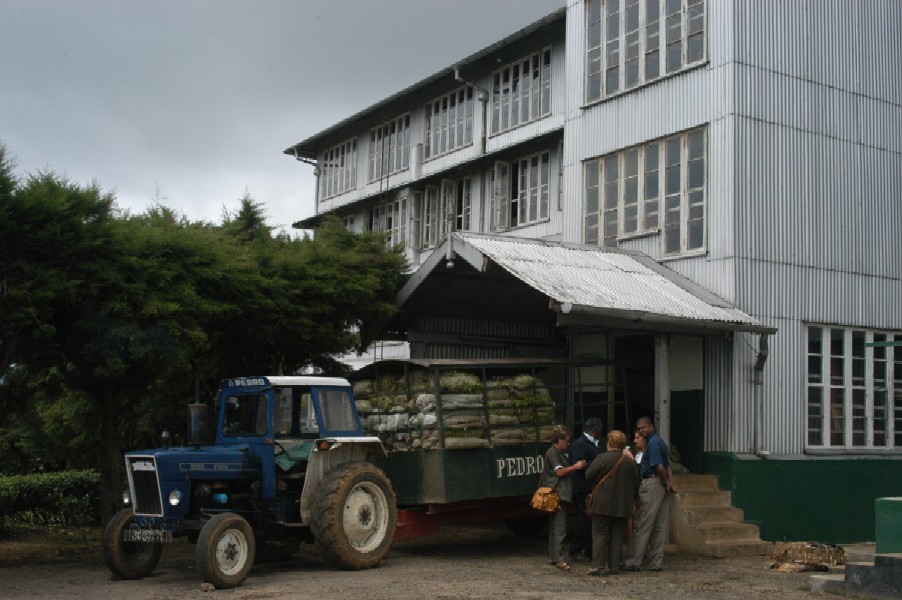 tea covered hills were beautiful. tea covered hills were beautiful.
Breakfast at our hotel was okay but still slow; there was only one poor waiter to take care of everyone and he tried very hard to keep up. The atmosphere was uncomfortably quiet and stale. All of the tourists kept quietly to themselves; all we could hear were muffled voices and the clinking of silverware against the plates. We were glad to finally get out and walk around the town a bit. The weather was better but showed signs of possibly changing. It was a nice stroll into the center of Nuwara Eliya past some early colonial-style homes but there wasn't really much to see downtown. We wanted to make a call home but the phone card we had didn't seem to work on any of the pay phones in town. We grabbed some snacks at a bakery and walked around but decided to try our luck at  going out to the Pedro Tea Estate. We weren't sure if it was open or not, and the hotel was totally useless in giving us any information. They couldn't be bothered to call and check for us. We asked one of the tuk-tuk drivers if it was open and he was assured us that it was but he was a dubious source of information since he wanted the fare. In the end we figured it was worth the ride out there since there was little else to do in Nuwara Eliya. going out to the Pedro Tea Estate. We weren't sure if it was open or not, and the hotel was totally useless in giving us any information. They couldn't be bothered to call and check for us. We asked one of the tuk-tuk drivers if it was open and he was assured us that it was but he was a dubious source of information since he wanted the fare. In the end we figured it was worth the ride out there since there was little else to do in Nuwara Eliya.
The countryside was beautiful, just rolling green hills full of tea bushes. As we approached the tea estate we saw women dressed in saris carrying baskets of tea leaves on their heads, bringing them to the factory for processing. The tea pickers are all women, mostly Tamils, and are paid very little for their long day's work. Their 6+ hours of work each day yielded about 13-15kg of leaves. The estate consisted of a handful of well worn buildings, their white painted exteriors standing out against the rich green landscape. Activity appeared to be in full swing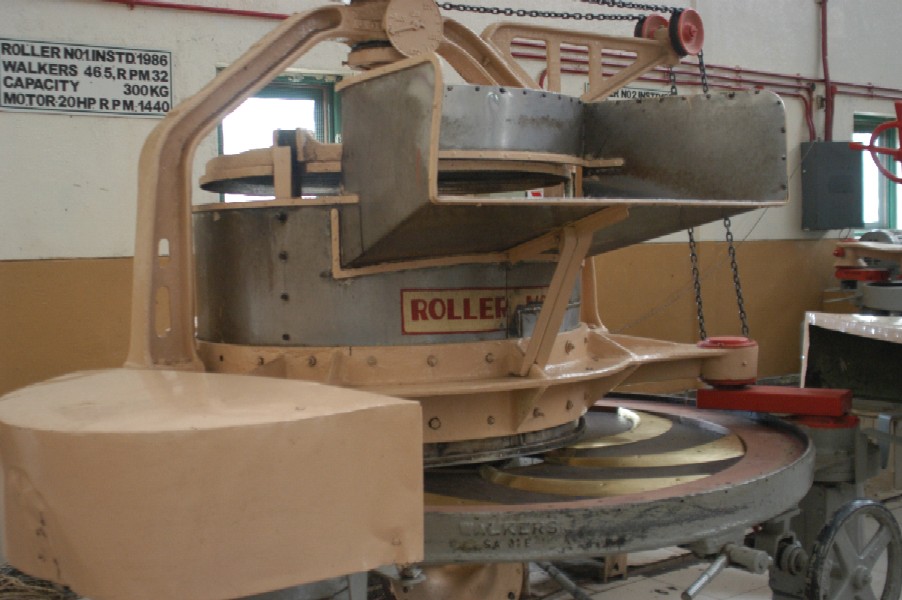 so our driver dropped us off and waited for us to take a tour. Inside the main office we paid a small fee and were assigned a smiling young man as our guide. so our driver dropped us off and waited for us to take a tour. Inside the main office we paid a small fee and were assigned a smiling young man as our guide.
Tea is one of Sri Lanka's major exports but only came to the country under the British in 1867. It was brought to replace the coffee farming that had been badly stricken with disease in 19th century. One account I read credited Britain's tea drinking legacy to the outbreak of this disease. Lo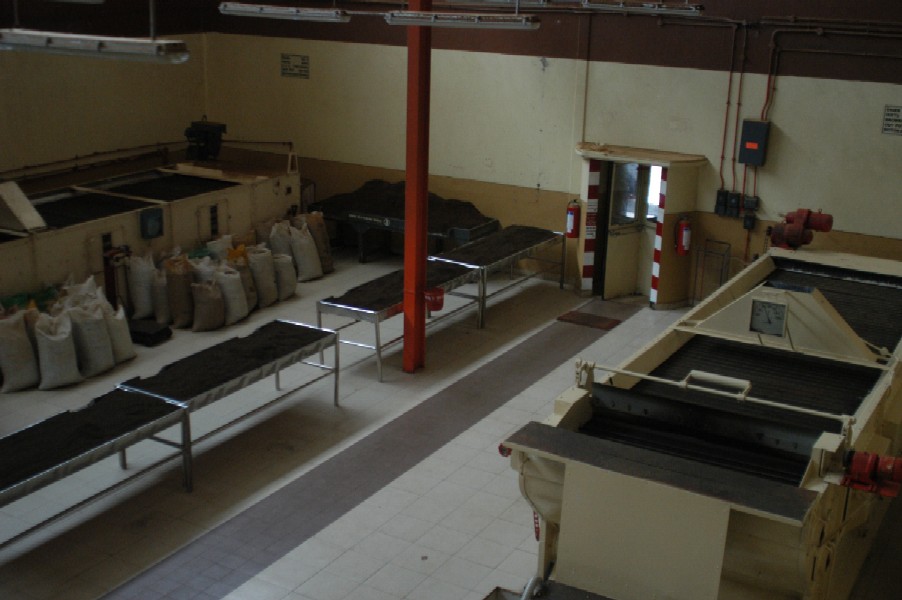 ndon had some of Europe's earliest coffee houses but when the colonies of India and Sri Lanka changed over to tea growing, so did British habits. The Pedro Tea Estate was established in 1885 and stood at 1890 meters with an annual rainfall of 1850mm and a mean temperature of 22 degrees Celsius. Combed with the sloping terrain this was an ideal location for growing tea. The estate was 660 hectares in size and in 2002 it turned out 782,000kg of tea! ndon had some of Europe's earliest coffee houses but when the colonies of India and Sri Lanka changed over to tea growing, so did British habits. The Pedro Tea Estate was established in 1885 and stood at 1890 meters with an annual rainfall of 1850mm and a mean temperature of 22 degrees Celsius. Combed with the sloping terrain this was an ideal location for growing tea. The estate was 660 hectares in size and in 2002 it turned out 782,000kg of tea!
Our tour started at the entrance of the main building, where all of the leaves were brought for processing. A truck was backed up to the front door and men were busy unloading the busting bags of leaves into the building. The leaves were picked in mixed sizes but always in two leaf and one bud clusters. The leaves were transported in 10kg bags twice per day from the fields. The bags were weighed and then thrown onto a lift that hauled them up to the top floor of the building. The leaves were then spread onto drying racks and left for 13 hours, shifting occasionally, while warm air (13°C) blown from below gently reduced the moisture to about 50%. At the end of the initial drying stage the leaves were orange-brown in color and slightly shriveled.
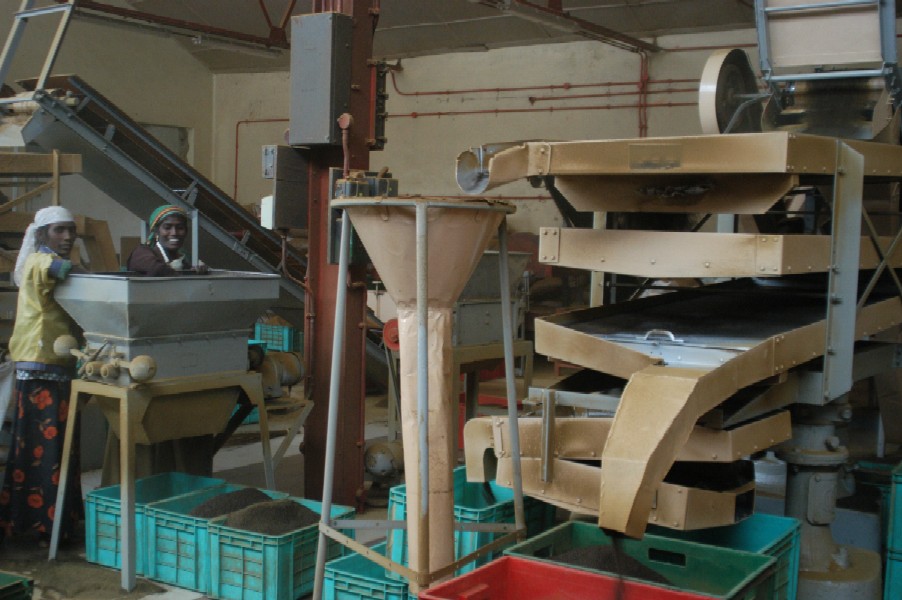 From the dryer the leaves were put through a crusher once and then chopped and sifted three times, each time sorting the leaves into higher quality (smaller pieces) from lower quality (larger pieces) and then commingled again. The final drying took place in a large oven where four large trays were stacked and heated to temperatures of 93° to 100°C. From the dryer the leaves were left to cool on long metal tables. About 4.5kg of fresh leaves yielded From the dryer the leaves were put through a crusher once and then chopped and sifted three times, each time sorting the leaves into higher quality (smaller pieces) from lower quality (larger pieces) and then commingled again. The final drying took place in a large oven where four large trays were stacked and heated to temperatures of 93° to 100°C. From the dryer the leaves were left to cool on long metal tables. About 4.5kg of fresh leaves yielded 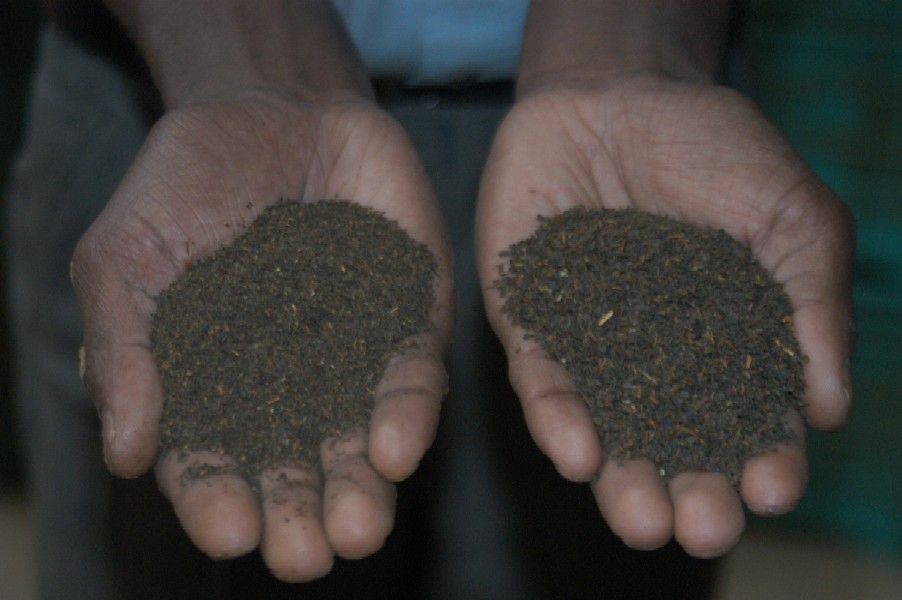 approximately 1kg of tea. A final sorting machine extracted the undrinkable rough bits (used as fertilizer) and sent the to a sifter that separated the tea into five separate qualities based in fineness of leaves. The very fine quality was the strongest and sold mostly in Sri Lanka. The medium-fine quality had a milder flavor and was mostly exported to Europe and the U.S. The rougher quality of tea was more popular where teas were brewed and served with milk, like the Middle East. And one variety didn't get chopped at all and yielded a milder tea, like Darjeeling tea. After the teas were sorted into bags they were sent off to be auctioned. While Sri Lanka reverted back to its original name in 1972, the term Ceylon, a European corruption of the term Sinhala-dvipa or island of the Sinhalese, is still used for the tea. approximately 1kg of tea. A final sorting machine extracted the undrinkable rough bits (used as fertilizer) and sent the to a sifter that separated the tea into five separate qualities based in fineness of leaves. The very fine quality was the strongest and sold mostly in Sri Lanka. The medium-fine quality had a milder flavor and was mostly exported to Europe and the U.S. The rougher quality of tea was more popular where teas were brewed and served with milk, like the Middle East. And one variety didn't get chopped at all and yielded a milder tea, like Darjeeling tea. After the teas were sorted into bags they were sent off to be auctioned. While Sri Lanka reverted back to its original name in 1972, the term Ceylon, a European corruption of the term Sinhala-dvipa or island of the Sinhalese, is still used for the tea.
The final stop on our tour was the professional tasting room where various teas were brewed and lined up for viewing, a rainbow of honey colored hues. Each cup was made from 2.5gm of tea and allowed to steep for two minutes. In order to maintain their delicate palates, the professional tasters weren't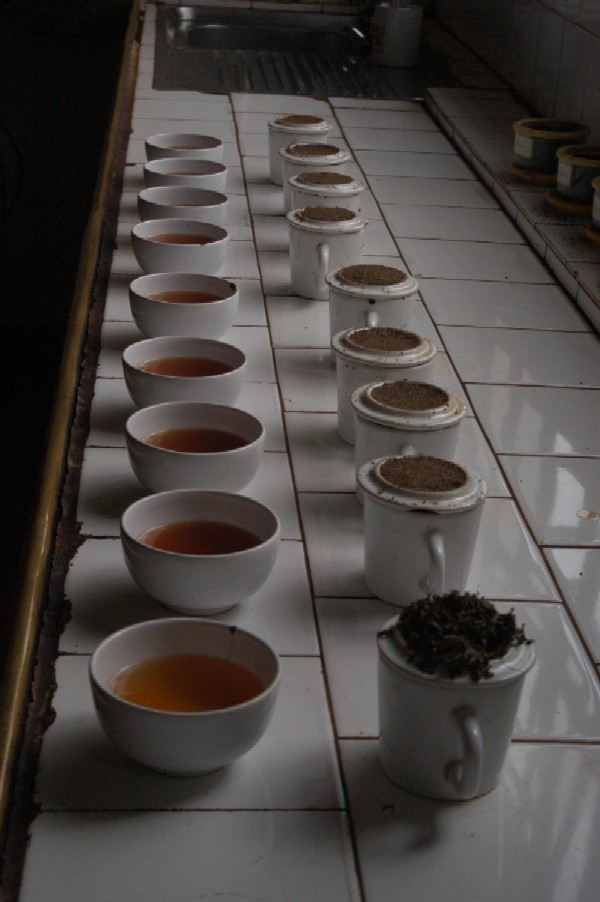 allowed to smoke or drink alcohol. Our tour ended back in the main office where we were served a very nice pot of Ceylon tea and, naturally, we bought some to take with us. allowed to smoke or drink alcohol. Our tour ended back in the main office where we were served a very nice pot of Ceylon tea and, naturally, we bought some to take with us.
In the afternoon the weather began to sour but before the rain got too heavy we walked up to the Hill Club, an old British men's club, and took in a bit of colonial atmosphere. The stately stone-faced building stood, as you might have guessed, on a hill. It had a well groomed lawn with neat white lawn chairs and carefully planted flowers. By modern standards it was rather modest but must have been quite a luxurious establishment -- back in the day. The Club was restricted to British men up until 1970 but now allows both Sri Lankans and women to grace its floors. As day guests we were charged a small fee that allowed us to use the public areas. We lounged in the library, a spacious room with white walls, wooden floors covered with an oriental rug, heavy brown leather chairs, and animal heads hanging on the walls. We grabbed a couple of the big chairs and had some tea served while we read and watched the rain pour down outside. 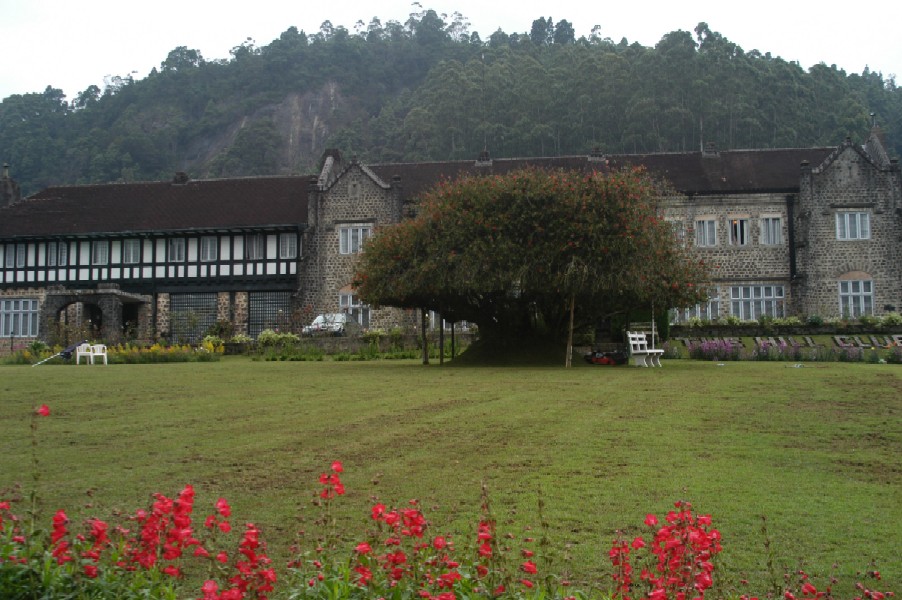 There were a few other people in the library when we arrived and it was quiet enough to hear a pin drop but once we became members the place just started to go down hill. We watched a cockroach creep across the floors and then a couple of rather unruly groups arrived to check into the guest rooms. They were British from the sound of them but they were very loud and the kids were running up and down the stairs. Those old colonial gents must have been rolling in their graves to have their stately establishment turned into a Motel 6. First the Americans joined, then the cockroach, and now this! We moved to the old women's lounge, near the former women's entrance, at the far end of the club but it soon got too dark to see well and there was a break in the rain so we made a run for it back into town. There were a few other people in the library when we arrived and it was quiet enough to hear a pin drop but once we became members the place just started to go down hill. We watched a cockroach creep across the floors and then a couple of rather unruly groups arrived to check into the guest rooms. They were British from the sound of them but they were very loud and the kids were running up and down the stairs. Those old colonial gents must have been rolling in their graves to have their stately establishment turned into a Motel 6. First the Americans joined, then the cockroach, and now this! We moved to the old women's lounge, near the former women's entrance, at the far end of the club but it soon got too dark to see well and there was a break in the rain so we made a run for it back into town. 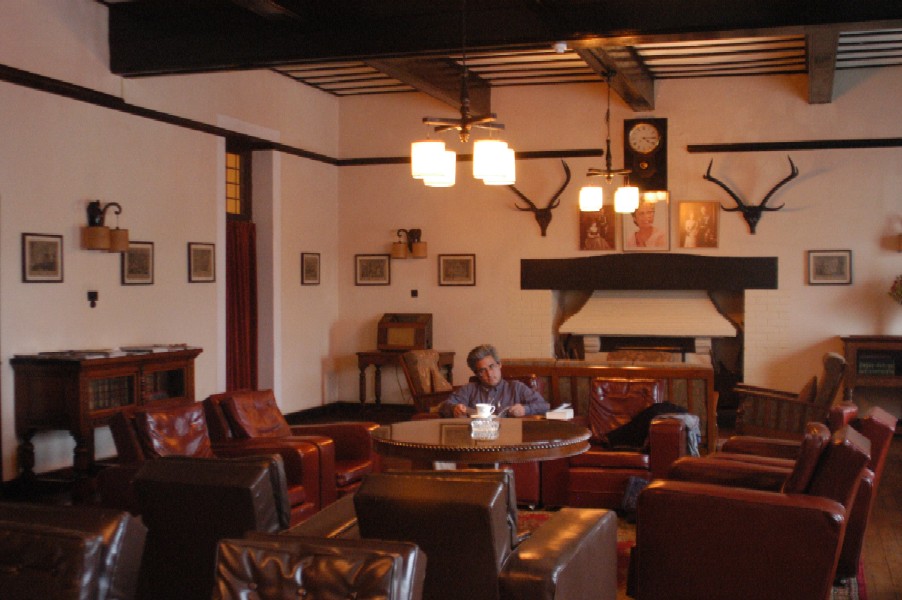
For dinner we stopped at a fast-food Indian restaurant, the Grand Indian. They weren't serving dinner yet so we ordered a snack and waited. The food wasn't great but probably better than at our hotel. We waited for another break in the rain before making our way through the dark streets back to our hotel. |

